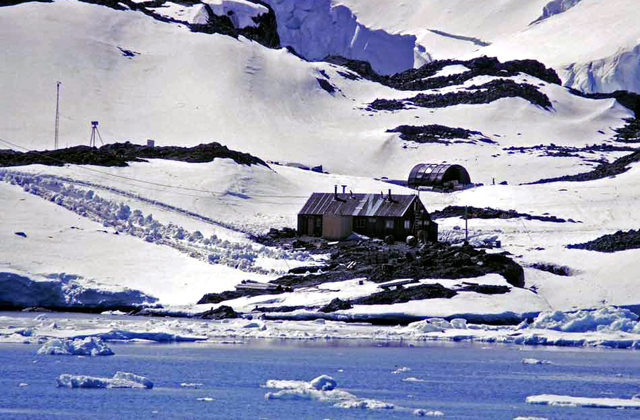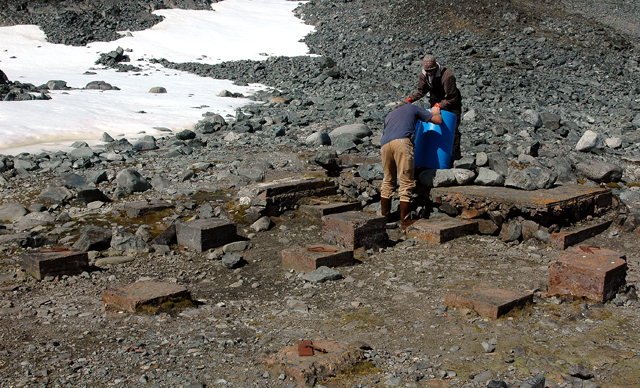History of Palmer StationUnited States has long been involved in exploration, research of Antarctic PeninsulaPosted May 21, 2010
Palmer Station Capt. John Biscoe discovered the island, though he believed he had found mainland Antarctica and claimed it for Great Britain in 1832. In 1955, the British founded Base N — a tiny, one-room structure located directly across Arthur Harbor from Palmer Station. The base was operated from 1955 through 1958. The United States first became interested in the Antarctic Peninsula in 1928 when the American Geographical Society Site selection included a wide variety of criteria: a biologically rich environment; an abundant fresh-water supply; an ice-free area for buildings; easy ship access; and potential access by heavy aircraft. Thirty-three sites were surveyed, and Anvers Island was selected as the closest to meeting all these critical requirements. By the spring of 1963, Arthur Harbor had been selected as the site of the first U.S. station on the peninsula. The survey team also recommended that a 125-foot ship be constructed to conduct biological work in the region, as well as to supply the station with personnel and provisions.
Construction of Palmer Station began in 1964, and it opened in February 1965 as the only U.S. Antarctic station north of the Antarctic Circle. The old British Base N, just a few feet away, was later made into a laboratory annex. After two successful winter seasons, plans were considered for the construction of a larger station to be located on Gamage Point, site of the current station. Also, the National Science Foundation U.S. Navy Seabees, which oversaw most of the logistics for the USAP in those days, began construction during the 1966-67 austral summer. The new Palmer Station was officially commission the next season, in March 1968. The station’s counterpart on the water, the research vessel Hero, arrived at Palmer Station on Christmas day in 1968. She ranged the peninsula trawling for biological specimens, and enjoyed a productive and colorful tour before she was retired in 1985. The original Palmer Station, or Old Palmer, is located across the harbor at a site called Norsel Point. In 2004, with the retreat of the Marr Ice Piedmont, it was discovered that Norsel Point was on an island separate from Anvers. The “new” island was named Amsler after U.S. Antarctic Program The Bio Lab Building and GWR (Garage/Warehouse/Recreation) building are the primary facilities for Palmer. These buildings are spaced wide enough apart to provide firebreaks, and both buildings are equipped with generators that can operate independently should there be a loss of either building to fire. A reverse-osmosis water system takes in water from Arthur Harbor to make drinking water. Kitchen and human waste are ground up and deposited in a high dispersal area in Arthur harbor. Numerous studies conducted at McMurdo Station Adapted from the Palmer Station website. Description of place names mentioned above as listed in the “Geographic Place Names of the Antarctic,” second edition, United States Board on Geographic Names, 1995. Anvers Island: High mountainous island, 38 miles long, which is the largest feature of the Palmer Archipelago, lying at the southwest end of the group. Named in 1898 during the Belgian Antarctic Expedition under Lt. Adrian Gerlache. Named after the province of Anvers, Belgium. Arthur Harbor: Small harbor entered between Bonaparte and Norsel points. Roughly charted by the French Antarctic Expedition of 1903-05. Surveyed by the Falkland Island Dependency Survey in 1955 and named by the UK Antarctic Place Names Committee in 1956 after Oswald Arthur, then governor of the Falklands Islands. Gamage Point: The rock point marking the north side of the entrance to Hero Inlet. Palmer Station is located on the point. Named after the Harvey Gamage Shipyard of South Bristol, Maine, which built the research vessel Hero. Marr Ice Piedmont: Large ice piedmont (coastal glacier) covering northwest half of Anvers Island. Likely first seen by a German expedition in 1873-74. Roughly surveyed by the French Antarctic Expeditions of 1903-05 and 1908-10. Named by the British for James W.S. Marr, a marine biologist with a long and distinguished Antarctic career. He was the first commander of the Falkland Islands Dependency Survey 1943-45 and base commander at nearby Port Lockroy. Marr also was a member of Douglas Mawson’s British-Australian-New Zealand Antarctic Expedition 1929-31 and Shackleton’s last expedition of 1921-22, which continued on after Shackleton’s death on South Georgia. Norsel Point: Rocky point on the northwest side of Arthur Harbor. Surveyed by the Falkland Island Dependency Survey (FIDS) in 1955. Named after the Norwegian sealing vessel Norsel, which was chartered by the FIDS to establish a base on the point during the 1954-55 summer season near the location of Old Palmer Station. Return to main story: Palmer Station |



For USAP Participants |
For The Public |
For Researchers and EducatorsContact UsU.S. National Science FoundationOffice of Polar Programs Geosciences Directorate 2415 Eisenhower Avenue, Suite W7100 Alexandria, VA 22314 Sign up for the NSF Office of Polar Programs newsletter and events. Feedback Form |




